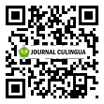CHINESE IDIOMS: SYNTACTIC FORMS AND CULTURAL VALUE
Keywords:
Chinese idioms, compositionality, syntactic opacity, metaphorsAbstract
Chinese idioms possess Chinese cultural values. This study aims at finding out the cultural reflection of Chinese idioms by analyzing their syntactic form. Apart from the Indonesian language, most Chinese idioms (??chéngy?) consist of four characters. In general, idioms have various forms, such as compounds, phrases, and clauses. These forms can also be found in Chinese idioms. However, it is difficult to determine the syntactic form of several idioms, in other words, some idioms are syntactically opaque. In addition, we will also examine idioms that are syntactically transparent along with the degree of the compositionality of their meaning. Therefore, there are two types of idioms: syntactically transparent idioms and syntactically opaque idioms. Moreover, idioms are also related to their own metaphorical sense. Metaphorical idioms show the user's language realm in expressing a situation, an action, or an event that is referred to. To find whether a metaphor exists in an idiom, we examine its contribution of the constituent meaning to its whole meaning. The idioms used in this research are four-character idioms, which are taken from the “Chinese Internet Corpus”, which is the most popular online corpus. The selected idioms from the online corpus will be verified using the “Xinhua Idiom Dictionary”.
References
Creswell, J. W. (2009). Research design: Qualitative, Quantitative, and Mixed Methods Approaches (3th ed.). California: SAGE Publications, Inc.
Cruse, A. (2000). Meaning in Language. Oxford: Oxford University Press.
Ding, F. (2018). Figurative Idioms and Culture. In Advances in Social Science, Education and Humanities Research (pp. 566–569). Atlantis Press.
Glucksberg, S. (2001). Understanding Figurative Language: From Metaphors to Idioms. New York: Oxford University Press.
Kridalaksana, H. (2007). Pembentukan Kata dalam Bahasa Indonesia. Jakarta: PT. Gramedia Pustaka Utama.
Langacker, R. W. (1986). Language and its Structure: Some Fundamental Linguistic Concepts. New York: Harcourt, Brace & World, Inc.
Ma, T. (2015). Cause Analysis of Different Culture Image in English and Chinese Animal Idiom. Asian Journal of Humanities and Social Sciences (AJHSS), 3, 10–19.
Rahyono, F. X. (2003). Intonasi Ragam Bahasa Jawa Keraton Yogyakarta Kontras Deklarativitas, Interogativitas, dan Imperativitas. Jakarta: Universitas Indonesia.
Roberts, I. (2007). Diachronic Syntax. Oxford: Oxford University Press.
Shi, S. (1979). Hanyu Chengyu Yanjiu. Sichuan: Sichuan University Press.
Widowatie, S. S. (2003). Idiom dalam Bahasa Mandarin: Kajian Sintaksis dan Semantis. Depok: Universitas Indonesia.
Wood, M. M. (1986). A Definition of Idiom. Indiana: Indiana University.
Wu, C. (1995). On the cultural traits of Chinese idioms. Intercultural Communication Studies, 61–84.
Xue, L., Cai, N., & Han, C. (2015). On Chinese Idiom Translation from Cultural Perspective. International Conference on Management, Computer and Education Informatization, 267–270. Atlantis Press.
Downloads
Published
Issue
Section
License
Copyright (c) 2022 Ayesa, Hermina Sutami

This work is licensed under a Creative Commons Attribution 4.0 International License.









